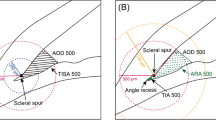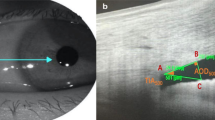Abstract
Purpose
To evaluate the association between baseline ocular variables and the widening of the anterior chamber angle by laser peripheral iridotomy (LPI) in primary angle closure suspects (PACS) using a new Fourier-domain swept-source anterior segment optical coherence tomography (FD-ASOCT).
Method
Sixty-six PACS eyes of 41 individuals were enrolled in this prospective interventional case series. An FD-ASOCT (Casia SS-1000 OCT; Tomey, Nagoya, Japan) was used to measure biometric baseline variables and at 1 month after the LPI. Paired t test was used to compare the difference between pre-and post-LPI measurements. Multivariate regression analysis was used to test for an association between baseline iris thickness and volume, anterior chamber depth and volume, and lens vault with a widening of the angle after an LPI. Changes in trabecular iris space area and angle opening distance after the LPI were main outcome measures.
Results
The mean age of participants was 58.6 ± 8.7 years, 68.2% of whom were female. The angle opening distance, recess area, and trabecular iris surface area at 500 μm increased by 48 to 73% (all P < 0.001). Lens vault and iris volume did not change. A low anterior chamber volume and low iris volume were associated with angle greater deepening by LPI.
Conclusion
Eyes with a shallow anterior chamber and thinner irises are more likely to experience angle opening from an LPI.



Similar content being viewed by others
References
Sun X, Dai Y, Chen Y et al (2017) Primary angle closure glaucoma: what we know and what we don’t know. Prog Retin Eye Res 57:26–45
Tham Y-C, Li X, Wong TY et al (2014) Global prevalence of glaucoma and projections of glaucoma burden through 2040: a systematic review and meta-analysis. Ophthalmology 121:2081–2090
Pakravan M, Yazdani S, Javadi M-A et al (2013) A population-based survey of the prevalence and types of glaucoma in Central Iran: the Yazd eye study. Ophthalmology 120:1977–1984
Lowe RF (1970) Aetiology of the anatomical basis for primary angle-closure glaucoma. Biometrical comparisons between normal eyes and eyes with primary angle-closure glaucoma. Br J Ophthalmol 54:161–169
Lee DA, Brubaker RF, Ilstrup DM (1984) Anterior chamber dimensions in patients with narrow angles and angle-closure glaucoma. Arch Ophthalmol 102:46–50
Marchini G, Pagliarusco A, Toscano A et al (1998) Ultrasound biomicroscopic and conventional ultrasonographic study of ocular dimensions in primary angle-closure glaucoma. Ophthalmology 105:2091–2098
Tarongoy P, Ho CL, Walton DS (2009) Angle-closure glaucoma: the role of the lens in the pathogenesis, prevention, and treatment. Surv Ophthalmol 54:211–225
Wang N, Ouyang J, Zhou W et al (2000) [Multiple patterns of angle closure mechanisms in primary angle closure glaucoma in Chinese]. Zhonghua Yan Ke Za Zhi 36:46–51 5, 6
Congdon NG, Youlin Q, Quigley H et al (1997) Biometry and primary angle-closure glaucoma among Chinese, white, and black populations. Ophthalmology 104:1489–1495
Nongpiur ME, He M, Amerasinghe N et al (2011) Lens vault, thickness, and position in Chinese subjects with angle closure. Ophthalmology 118:474–479
Thomas R, George R, Parikh R et al (2003) Five year risk of progression of primary angle closure suspects to primary angle closure: a population based study. Br J Ophthalmol 87:450–454
Schwartz LW, Rodrigues MM, Spaeth GL et al (1978) Argon laser iridotomy in the treatment of patients with primary angle-closure or pupillary block glaucoma: a clinicopathologic study. Ophthalmology 85:294–309
Lei K, Wang N, Wang L, Wang B (2007) Morphological changes of the anterior segment after laser peripheral iridotomy in primary angle closure. Eye 23:345–350
McGalliard JN, Wishart PK (1990) The effect of Nd:YAG iridotomy on intraocular pressure in hypertensive eyes with shallow anterior chambers. Eye 4(Pt 6):823–829
Dada T, Mohan S, Sihota R et al (2007) Comparison of ultrasound biomicroscopic parameters after laser iridotomy in eyes with primary angle closure and primary angle closure glaucoma. Eye 21:956–961
He M, Friedman DS, Ge J et al (2007) Laser peripheral iridotomy in eyes with narrow drainage angles: ultrasound biomicroscopy outcomes. The Liwan Eye Study. Ophthalmology 114:1513–1519
Yao B-Q, Wu L-L, Zhang C, Wang X (2009) Ultrasound biomicroscopic features associated with angle closure in fellow eyes of acute primary angle closure after laser iridotomy. Ophthalmology 116:444–448.e2
Gazzard G, Friedman DS, Devereux JG et al (2003) A prospective ultrasound biomicroscopy evaluation of changes in anterior segment morphology after laser iridotomy in Asian eyes. Ophthalmology 110:630–638
Lee KS, Sung KR, Kang SY et al (2011) Residual anterior chamber angle closure in narrow-angle eyes following laser peripheral iridotomy: anterior segment optical coherence tomography quantitative study. Jpn J Ophthalmol 55:213–219
Quigley HA (1981) Long-term follow-up of laser iridotomy. Ophthalmology 88:218–224
Pollack IP (1981) Laser iridotomy in the treatment of angle-closure glaucoma. Ann Ophthalmol 13:549–550
Friedman DS (2001) Who needs an iridotomy? Br J Ophthalmol 85:1019–1021
How AC, Baskaran M, Kumar RS et al (2012) Changes in anterior segment morphology after laser peripheral iridotomy: an anterior segment optical coherence tomography study. Ophthalmology 119:1383–1387
Lee RY, Kasuga T, Cui QN et al (2014) Association between baseline iris thickness and prophylactic laser peripheral iridotomy outcomes in primary angle-closure suspects. Ophthalmology 121:1194–1202
Foster PJ, Buhrmann R, Quigley HA, Johnson GJ (2002) The definition and classification of glaucoma in prevalence surveys. Br J Ophthalmol 86:238–242
Shaffer RN (1960) Primary glaucomas. Gonioscopy, ophthalmoscopy and perimetry. Trans Am Acad Ophthalmol Otolaryngol 64:112–127
Liu S, Li H, Dorairaj S et al (2010) Assessment of scleral spur visibility with anterior segment optical coherence tomography. J Glaucoma 19:132–135
Mak H, Xu G, Leung CK-S (2013) Imaging the iris with swept-source optical coherence tomography: relationship between iris volume and primary angle closure. Ophthalmology 120:2517–2524
Liu S, Yu M, Ye C et al (2011) Anterior chamber angle imaging with swept-source optical coherence tomography: an investigation on variability of angle measurement. Invest Ophthalmol Vis Sci 52:8598–8603
Lee RY, Kasuga T, Cui QN et al (2013) Association between baseline angle width and induced angle opening following prophylactic laser peripheral iridotomy. Invest Ophthalmol Vis Sci 54:3763–3770
Yoong Leong JC, O’Connor J, Soon Ang G, Wells AP (2014) Anterior segment optical coherence tomography changes to the anterior chamber angle in the short-term following laser peripheral iridoplasty. J Curr Glaucoma Pract 8:1–6
Ang BCH, Nongpiur ME, Aung T et al (2016) Changes in Japanese eyes after laser peripheral iridotomy: an anterior segment optical coherence tomography study. Clin Exp Ophthalmol 44:159–165
Ng WT, Morgan W (2012) Mechanisms and treatment of primary angle closure: a review. Clin Exp Ophthalmol 40:e218–e228
He M, Lu Y, Liu X et al (2008) Histologic changes of the iris in the development of angle closure in Chinese eyes. J Glaucoma 17:386–392
Oka N, Otori Y, Okada M et al (2006) Clinical study of anterior ocular segment topography in angle-closure glaucoma using the three-dimensional anterior segment analyzer Pentacam. Nippon Ganka Gakkai Zasshi 110(5):398–403
Coakes RL, Lloyd-Jones D, Hitchings RA (1979) Anterior chamber volume. Its measurement and clinical application. Trans Ophthalmol Soc U K 99:78–81
Dorairaj S, Liebmann JM, Ritch R (2007) Quantitative evaluation of anterior segment parameters in the era of imaging. Trans Am Ophthalmol Soc 105:99–108 discussion 108–10
Radhakrishnan S, Goldsmith J, Huang D et al (2005) Comparison of optical coherence tomography and ultrasound biomicroscopy for detection of narrow anterior chamber angles. Arch Ophthalmol 123:1053–1059
Funding
We acknowledge support from the Initiative to Cure Glaucoma of the Eye and Ear Foundation of Pittsburgh; NIH CORE Grant P30 EY08098 to the Department of Ophthalmology, and from an unrestricted grant from Research to Prevent Blindness, NY, NY.
Author information
Authors and Affiliations
Corresponding author
Ethics declarations
Conflict of interest
NAL has received honoraria for Trabectome wet labs and lectures from Neomedix Corp.
Ethical approval
All procedures performed in studies involving human participants were in accordance with the ethical standards of the institutional and/or national research committee and with the 1964 Helsinki declaration and its later amendments or comparable ethical standards.
Consent
Written consent form was received from all participants in this study.
Electronic supplementary material
Supplementary Table 1
(DOCX 15 kb)
Rights and permissions
About this article
Cite this article
Esfandiari, H., Pakravan, M., Amouhashemi, N. et al. Low iris and anterior chamber volume is associated with deepening after laser peripheral iridotomy in primary angle closure suspects. Graefes Arch Clin Exp Ophthalmol 256, 2173–2179 (2018). https://doi.org/10.1007/s00417-018-4092-8
Received:
Revised:
Accepted:
Published:
Issue Date:
DOI: https://doi.org/10.1007/s00417-018-4092-8




